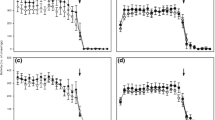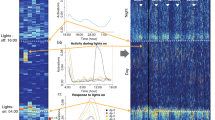Abstract
Home-cage running-wheel activity of mice congentally infected withToxoplasma was recorded over 24 days. Infected mice were consistently more active than uninfected controls over the entire testing period. This finding extends previous studies and indicates that such increased activity levels occur not only in novel but also in familiar environments, and suggests that congenital toxoplasmosis tends to render mice ‘hyperactive’. If such behavioural alterations occur in wild mice, it is likely that infected mouse intermediate hosts would be more susceptible to predation by cats, the definitive hosts ofToxoplasma.
Similar content being viewed by others
References
Beverley JKA (1959) Congenital transmission ofToxoplasma through successive generations of mice. Nature (London) 183:1348–1349
Capobianco S, Hamilton LW (1976) Effects of interruption of limbic system pathways on different measures of activity. Physiol Behav 17:65–72
Desmonts G, Remington JS (1980) Direct agglutination test for diagnosis ofToxoplasma infection: method for increasing sensitivity and specificity. J Clin Microbiol 11:562–568
Festing MFW, Greenwood R (1976) Home-cage wheel activity recording in mice. Lab Anim 10:81–85
Graham DI, Hay J, Hutchison WM, Siim JC (1984) Encephalitis in mice with congenital oculartoxoplasmosis. J Pathol 142:265–277
Hay J (1982) Behavioural and ocular manifestation accompanyingToxoplasma gondii infection in mice. PhD Thesis, University of Strathclyde
Hay J, Aitken PP, Hutchison WM, Graham DI (1983a) The effect of congenital and adult-acquired acquiredToxoplasma infections on the motor performance of mice. Ann Trop Med Parasitol 77:261–277
Hay J, Hutchison WM, Aitken PP, Graham DI (1983b) The effect of congenital and adult-acquiredToxoplasma infections on activity and responsiveness to noval stimulation in mice. Ann Trop Med Parasitol 77:483–495
Hay J, Aitken PP, Graham DI (1984a)Toxoplasma infection and response to novelty in mice. Z Parasitenkd 70:575–588
Hay J, Aitken PP, Hair DM, Hutchison WM, Graham DI (1984b) The effect of congenitalToxoplasma infections on mouse activity and relative preference for exposed areas over a series of trials. Ann Trop Med Parasitol 78:611–618
Hay J, Hair DM, Graham DI (1984c) Localization of brain damage in mice followingToxoplasma infection. Ann Trop Med Parasitol 78:657–659
Leyhausen P (1979) Cat behaviour: The predatory and social behaviour of domestic and wild cats. Garland Series in Ethology, Garland S.T.P.M. Press, New York, London
Sabin AB, Feldman HA (1948) Dyes as microchemical indicators of a new immunity phenomenon affecting a protogoan parasite (Toxoplasma). Science 108:660–663
Skinner BF (1933) The measurement of ‘spontaneous activity’. J Gen Physiol 9:3–23
Winer BJ (1962) Statistical principles in experimental design. McGraw-Hill, New York, London
Author information
Authors and Affiliations
Rights and permissions
About this article
Cite this article
Hay, J., Aitken, P.P. & Arnott, M.A. The influence of congenitalToxoplasma infection on the spontaneous running activity of mice. Z. Parasitenkd. 71, 459–462 (1985). https://doi.org/10.1007/BF00928348
Accepted:
Issue Date:
DOI: https://doi.org/10.1007/BF00928348




